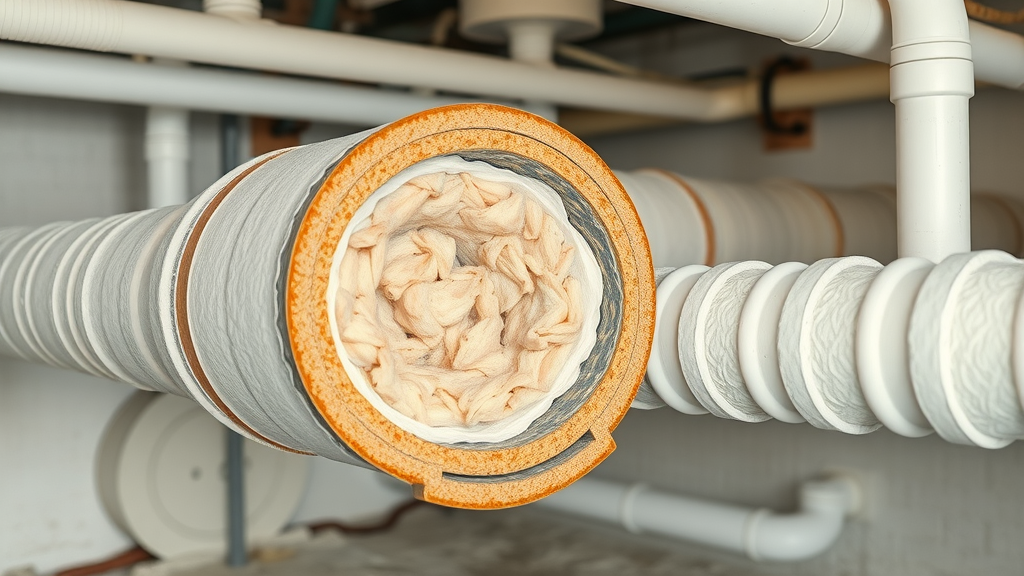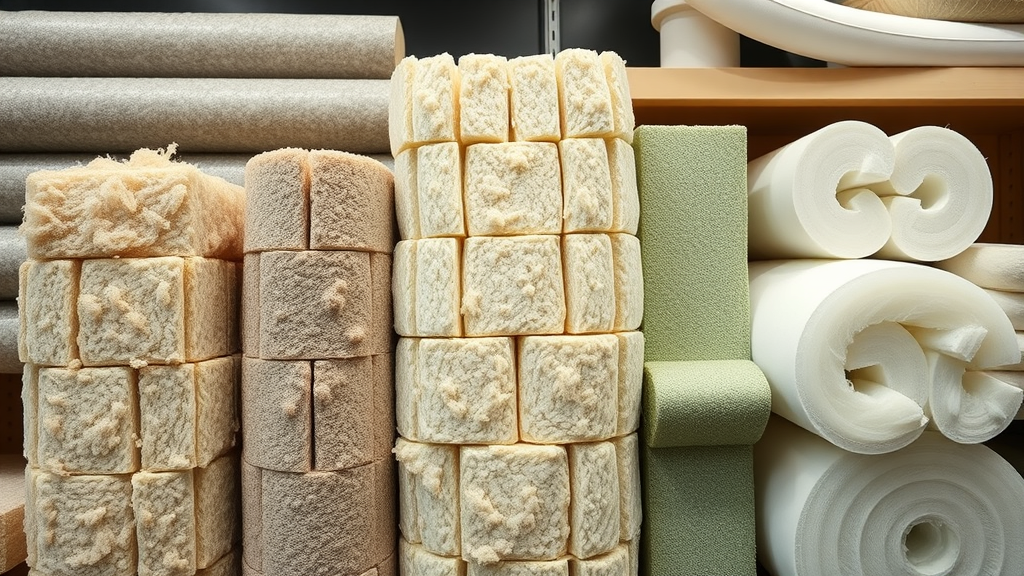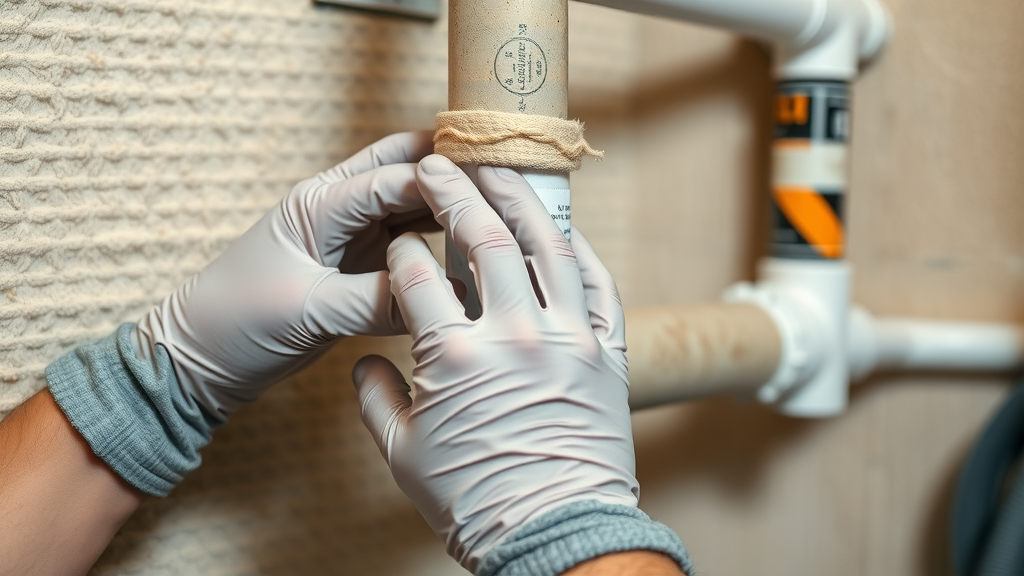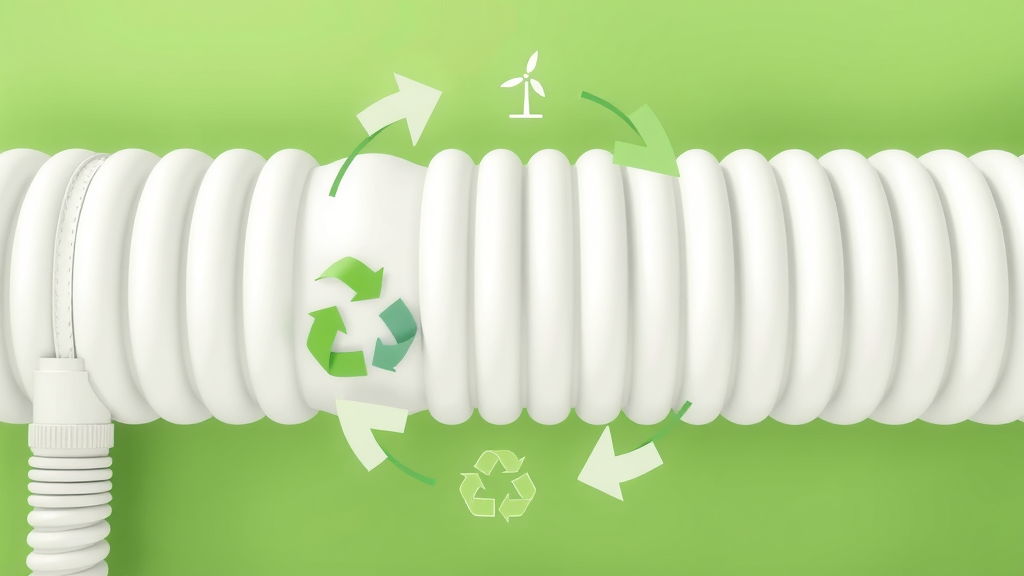Did you know that over 2 million tons of traditional insulation end up in landfills every year? What’s hidden inside your walls and basements could add to landfill waste and hazardous runoff—unless you switch to a more sustainable solution. In an era where energy efficiency and environmental responsibility are more critical than ever, upgrading to eco-friendly pipe insulation can shrink your carbon footprint, lower ongoing bills, and future-proof your home or business. Read on to discover practical steps and essential facts you need to start making a positive change—right now.
The Unseen Impact: Why Eco-Friendly Pipe Insulation Matters
Did you know that traditional pipe insulation contributes to landfill waste and toxic environmental runoff every year? Discover how switching to eco-friendly pipe insulation can reduce your carbon footprint and energy bills.
Eco-friendly pipe insulation is a critical yet often overlooked piece of the energy-saving and environmental puzzle. Traditional materials, like conventional foam or certain fiberglass insulation, can leach toxic chemicals into the environment during both manufacture and disposal. Over time, these substances contaminate soil and water sources, increasing the planet’s ecological burden. Besides waste concerns, production of standard insulation materials emits significant greenhouse gases, further accelerating climate challenges.
Choosing environmentally friendly alternatives for your piping systems immediately lessens your impact. Modern sustainable insulation options not only minimize pollutants and landfill contribution but also enhance energy efficiency in your home and commercial buildings. This means water pipes, cold pipe systems, and other installations retain more heat or cold with less energy waste. Adopting greener materials is a direct line to reducing utility bills and greenhouse gas emissions for years to come—a win for your wallet and the planet.

Choosing the Right Eco-Friendly Pipe Insulation for Your Needs
Explore practical examples of eco-friendly pipe insulation for water pipes, cold pipe, and hot water pipe systems, giving you the confidence to make the best choice for your property.
Before you start building or retrofitting, it is key to pinpoint the pipe insulation option that aligns with both your performance and eco-responsibility goals. There are different materials tailored for cold water pipes , hot water pipes , and general piping systems . For example, mineral wool stands out for its non-combustible nature, high thermal and acoustic insulation, and ultra-low environmental impact. Foam insulation made from renewable or recycled materials offers flexibility for tight spaces and resilience against moisture—a top choice for areas prone to condensation, like air conditioning lines or basement piping.
Fiberglass insulation has long been used for its thermal resistance and cost-effectiveness, but not all versions are equally green. Choose products with low embodied energy and certified recycled content to truly lessen your footprint. As you consider eco-friendly insulation made from plant fibers, natural foams, or even recycled glass fibers, pay close attention to their compatibility with your pipe type, climate, and safety needs. The right insulation product could mean the difference between repeat repairs and decades of comfortable, efficient performance.
Comprehensive Guide to Pipe Insulation Options for Sustainability
Pipe insulation basics and eco-friendly differences
Primary insulation options: mineral wool, foam insulation, fiberglass insulation
The benefits of selecting environmentally friendly products over conventional pipe lagging
Step-by-step: How to assess and choose insulation options for energy efficiency and environmental responsibility
Pipe insulation serves as your first line of defense against wasted energy and condensation damage, especially in cold pipe and water pipe applications. But what separates eco-friendly options from conventional ones? First, consider the insulation materials themselves: mineral wool is crafted from natural basalt or recycled slag and boasts an extremely low carbon footprint. Natural foam insulation —often made from soy, castor oil, or recycled plastics—brings additional flexibility and moisture resistance, perfect for air conditioning and cold pipes . Standard fiberglass insulation can be more energy-intensive to create, but newer formulas integrate up to 80% recycled glass fibers to bridge the gap.
For property owners, evaluating energy efficiency ratings and environmental certifications is essential when choosing pipe insulation products . A few steps to guide decision-making: First, identify the location and type of pipes (hot, cold, or water pipe); second, choose an insulation thickness that matches your climate zone; third, seek materials that are non-toxic, low-VOC, and easy to recycle. Don’t underestimate the value of third-party certifications, such as GREENGUARD or Cradle to Cradle, which verify a product’s green credentials. By selecting thoughtfully, you maximize both cost savings and your positive environmental impact.

How Eco-Friendly Pipe Insulation Boosts Energy Efficiency
Reducing Heat Loss in Water Pipes and Cold Pipe Systems
Explore the science behind pipe insulation and thermal loss
How eco-friendly materials outperform standard options for long-term cost savings
Insulating both hot water pipes and cold pipe lines is critical in any energy-conscious property. Without adequate insulation, pipes lose or gain heat rapidly, forcing water heaters, air conditioners, or boilers to work harder—wasting energy and spiking utility bills. High-quality pipe insulation materials —like mineral wool or eco-friendly foam insulation —create a protective barrier that greatly reduces thermal conductivity. This means both your heated water and chilled lines remain at their desired temperatures for longer periods.
What sets eco-friendly options apart is not just their ability to match or exceed conventional insulation in performance, but their sustainability. For example, natural foam insulation products leverage renewable resources and contain no harmful CFCs or HCFCs, reducing their environmental impact at each stage. Pipe lagging with low VOC content also promotes healthier indoor air—a significant draw for residential and commercial spaces alike. Over time, the energy saved more than pays back the initial cost difference, making these an intelligent investment.

Maximizing Performance with Sustainable Insulation Options
Energy efficiency ratings for leading eco-friendly pipe insulation products
Real-world examples of improved energy performance in commercial and residential applications
Energy efficiency is measured by an insulation’s “R-value,” or its resistance to thermal flow. Leading eco-friendly pipe insulation products—like mineral wool and high-density natural foam—typically deliver R-values on par with, or superior to, their non-green counterparts. Recent case studies in both residential upgrades and commercial retrofits reveal a consistent drop in energy demand after switching to these sustainable options. In large commercial buildings, losses from cold pipes or long water pipe runs are minimized, cutting monthly costs and boosting system lifespans.
The advantages extend beyond just numbers: sustainable insulation is designed for longevity and safe handling, with insulation made from renewable sources often certified for both indoor air quality and environmental stewardship. Choosing products with industry-leading ratings empowers homeowners and building managers to future-proof their properties—improving overall comfort and ensuring they meet or exceed increasingly strict building codes.
Comparing Pipe Insulation Materials: From Fiberglass to Mineral Wool and More
Insulation Material |
Environmental Impact |
R-Value |
Durability |
Price Point |
|---|---|---|---|---|
Fiberglass Insulation |
Moderate |
High |
Medium |
$$ |
Mineral Wool |
Low |
High |
High |
$$$ |
Natural Foam Insulation |
Very Low |
Medium-High |
High |
$$$ |
Conventional Foam |
High |
High |
High |
$$ |
Why Mineral Wool and Eco-Friendly Foams Lead the Market
Breakdown of eco advantages, health impacts, and disposal processes for mineral wool and eco-friendly foams
Mineral wool and green foams are the frontrunners in sustainable pipe insulation products . Mineral wool, derived from abundant natural materials, offers a lifecycle with the lowest environmental footprint: renewable raw inputs, non-toxic processing, and safe disposal—often even compostable or recyclable. Eco-friendly foams, especially those made from plant-based or recycled plastics, forgo ozone-depleting chemicals and offer straightforward recycling pathways at end-of-life. These advantages translate to healthier installation environments and safe indoor air, even in tight spaces and tricky corners of your piping system .
When it comes to disposal and health, the choice is clear. Older fiber- or plastic-based insulation carries risks, from glass fiber particles to toxic dust and off-gassing. Eco-friendly insulation options are engineered to minimize these hazards, promoting not only a greener planet but also a safer workspace for installers and occupants alike.
Features and Benefits of Eco-Friendly Pipe Insulation Products
Non-toxic and low-VOC formulations
Sustainable sourcing and certifications
Enhanced durability for water pipe and cold pipe applications
Today’s best eco-friendly pipe insulation materials deliver more than just greener sourcing. Non-toxic and low-VOC chemical profiles mean that your water pipes , cold water pipes , and even air conditioning lines benefit from improved indoor air quality, limiting risks for everyone in the building. Sustainability doesn’t end with the ingredients: top brands back up their claims with transparent supply chains and third-party certifications like GREENGUARD, signaling safer, responsible choices along the entire product lifecycle.
Durability is another hallmark of sustainable insulation products. Natural foam, recycled glass fibers, and mineral wool resist moisture, pests, and temperature swings, preserving their performance over decades and minimizing maintenance headaches. Many of the best pipe insulation materials can withstand high temperatures and repeated handling, making them ideal for long runs, exposed outdoor pipe, or demanding industrial applications.

Best Eco-Friendly Pipe Insulation Products and Brands Reviewed
Top-rated eco-friendly pipe insulation for residential and commercial use
User reviews and expert recommendations
Navigating today’s market for eco-friendly pipe insulation can be daunting given all of the new product launches and evolving standards. Leading brands such as Roxul (for mineral wool ), Armaflex Nature (for bio-based foam insulation), and Owens Corning (for recycled-content fiberglass insulation ) have set themselves apart with robust testing, outstanding R-values, and transparency in sourcing. User feedback often highlights ease of installation, flexible fitting for tight spaces , and a remarkable drop in monthly energy bills post-retrofit.
Expert reviews consistently recommend prioritizing certifications and region-specific compatibility—local climate conditions, pipe type (hot, cold pipe , or water pipe ), and planned system upgrades. Explore user forums, contractor recommendations, and product warranty details before you buy, and don’t hesitate to ask your supplier for performance data relevant to your specific needs.
Installation Tips: How to Fit Eco-Friendly Pipe Insulation for Maximum Impact
DIY installation steps for pipe insulation, water pipes, and cold pipe
Safety considerations: why eco-friendly options make the job safer
Essential tools and best practices
Whether you’re an experienced DIYer or calling in a pro, installing eco-friendly pipe insulation is straightforward and rewarding. Begin by cleaning your water pipes or cold pipes and measuring the insulation thickness needed for optimal protection. Most sustainable options—such as mineral wool sheaths or foam tubes—can be trimmed easily with hand tools and secured over clean pipes with tape or specially designed fasteners. Pay special attention to elbows and joints, using flexible material or custom wraps to seal any gaps.
Eco-friendly insulation options shine when it comes to safety. With no glass fibers, harsh dust, or off-gassing chemicals, these installations are easier on your skin and lungs. Always wear gloves and a mask for maximum protection, but rest assured that handling modern products reduces common risks faced with older, conventional insulation. Follow the manufacturer’s best practices, ensure proper overlapping, and check for complete coverage—especially near external walls where thermal and acoustic losses are highest.
Cost and Lifespan: Investing in Eco-Friendly Pipe Insulation
Comparing price points across insulation options
Calculating payback period from energy savings
Longevity analysis: eco-friendly pipe lagging versus conventional materials
While eco-friendly pipe insulation may carry a premium up front, long-term savings far outweigh initial investments. As detailed in our earlier table, options like mineral wool and natural foam have higher price points but offer robust durability and striking energy savings. Over five to seven years, many homeowners report full payback through lower heating and cooling bills alone. Additionally, the rugged build of green insulation rarely requires replacement over a property’s lifespan, ensuring more value per dollar spent.
Don’t forget non-financial returns: safety, indoor air quality, and the satisfaction of contributing to a healthier planet. Eco-friendly pipe lagging options minimize exposure to harmful substances for both installers and residents, while also reducing landfill contribution and greenhouse gas emissions. If you’re on the fence, consider requesting an energy audit to compare expected savings or check local incentives, which can further sweeten the investment.

Pipe Insulation Regulations and Certifications: What to Look for When Choosing Eco-Friendly Options
Green certifications (e.g., GREENGUARD, Cradle to Cradle)
Compliance with local and international standards
Impact on building code adherence and resale value
Choosing an eco-friendly pipe insulation product isn’t just about material composition—it’s about trust. Look for green certifications like GREENGUARD, Cradle to Cradle, or even regional energy star labels to ensure performance and impact. Many jurisdictions now insist that pipe insulation materials meet stringent VOC, fire resistance, and recycling benchmarks to comply with evolving building codes.
Certified insulation not only helps with compliance but can also boost your property’s resale value and make insurance processes smoother. Buyers and inspectors increasingly seek third-party-verified proof of sustainability and safety, making the right choice a meaningful investment for years to come.
Environmental Impact: The Case for Sustainable Pipe Lagging and Insulation Options
Life cycle assessment: from raw materials to disposal
Reduced greenhouse gas emissions
Circular economy and recycling opportunities
The full life cycle assessment for eco-friendly pipe insulation starts with renewable or recycled raw materials, extends through efficient manufacturing, and concludes with safe, often recyclable end-of-life disposal. Unlike standard options that end up as non-biodegradable waste, green insulation fits into a circular economy—resources are reused, not wasted, and emissions are minimized along the way.
Reduced greenhouse gas emissions are just the beginning; sustainable pipe lagging supports a holistic shift toward low-carbon living. As the industry continues to innovate, look for products that declare not only recycled content but also plans for take-back or closed-loop systems, narrowing the gap between use and reuse for future generations.

Case Studies: Eco-Friendly Pipe Insulation in Real-World Applications
Commercial retrofits
Residential upgrades
Measurable environmental and cost benefits
From massive office complexes to single-family homes, the benefits of eco-friendly pipe insulation are resonating in real-world projects. In recent commercial retrofits , clients have reported up to a 30% drop in annual heating bills, while property managers have praised improved “green building” ratings and enhanced tenant satisfaction. Residential upgrades yield similar payoffs, with homeowners noting less condensation, fewer maintenance calls, and a noticeable boost in comfort.
These case studies underscore not only measurable energy and cost savings, but a dramatic decrease in environmental impact. When paired with smart thermostats or energy-efficient boilers, the return on investment in sustainable insulation options is even more compelling, aligning with global trends in green building and property management.
Expert Insights on Pipe Insulation Trends and the Shift to Sustainability
"Choosing eco-friendly pipe insulation isn’t just good for the planet—it’s a smart long-term investment for your property." — Green Building Consultant
Industry trends in sustainable insulation materials
Predictions for the future of pipe lagging innovation
Leading voices in the insulation field point to an ongoing shift: as climate awareness rises and consumers demand healthier homes, the market for eco-friendly pipe insulation is booming. Innovations are trending towards non-toxic, bio-based, and fully recyclable materials, with a parallel focus on smart, easy-fit solutions for both new builds and retrofits. Research and development continue to push for higher R-values and lower embodied carbon, ensuring that future insulation options will be even more eco-effective and user-friendly.
Looking ahead, expect stricter regulations, greater transparency in manufacturing, and a surge in products that truly embed circular economy principles. Now is the perfect time for property owners and builders to upgrade—securing savings, comfort, and peace of mind for decades to come.
Which insulation is most environmentally friendly?
Mineral wool and natural foam insulation are among the most environmentally friendly pipe insulation materials, offering low embodied energy and safe end-of-life disposal.
The most environmentally friendly pipe insulation option today is mineral wool , closely followed by natural foam insulation . These materials are primarily made from renewable, recycled, or naturally abundant resources, contain no toxic additives, and can often be safely recycled or composted at the end of their service life. Their low embodied energy and sustainability certifications ensure they outperform most conventional insulation materials in both green building and sustainability metrics.
What can I use instead of pipe insulation?
Alternatives include recycled natural fibers, aerogel wraps, and even reusing textiles, but these may not match the performance of dedicated eco-friendly pipe insulation.
While eco-friendly pipe insulation options are best for energy efficiency and longevity, other alternatives include recycled denim wraps, aerogel sheets for high-performance tasks, or even upcycled textiles for short-term needs. However, these alternatives often lack the full moisture resistance or R-value of purpose-engineered insulation products . For lasting results, invest in sustainable insulation specifically designed and certified for your piping systems .
What is the most energy efficient pipe insulation?
High-density eco-friendly foam and mineral wool often provide superior energy efficiency for water pipes and cold pipe setups.
In terms of energy efficiency , high-density eco-friendly foam insulation and mineral wool currently offer the top performance. Their advanced construction traps heat or cold more effectively, translating into higher R-values and lower thermal loss for both water pipes and cold pipe systems. Always look for third-party R-value ratings on pipe insulation products to ensure you’re getting the optimal protection for your investment.
What is the eco friendly alternative to PVC pipe?
Alternatives include PEX, stainless steel, copper, and biocomposite pipes, each compatible with eco-friendly pipe insulation materials for a fully sustainable solution.
Eco-friendly alternatives to traditional PVC pipes include PEX piping , stainless steel, copper, and new biocomposite pipelines. Each of these piping options boasts improved environmental credentials and is fully compatible with sustainable pipe insulation for a holistic green system. Ask your installer which combinations suit your local building code and long-term sustainability goals for the best result.
Summary: Why Eco-Friendly Pipe Insulation Is Essential for Every Property
Reduce your carbon footprint
Lower your energy costs
Future-proof your property
Support a healthier indoor environment
Frequently Asked Questions About Eco-Friendly Pipe Insulation
Is eco-friendly pipe insulation more expensive? Often, initial costs are slightly higher, but long-term savings offset this difference.
Does eco-friendly insulation last as long as conventional materials? With proper installation, lifespan is comparable or superior.
Can I retrofit my existing water pipes and cold pipe with sustainable options? Yes, most products are designed for retrofitting purposes.
Eco-friendly pipe insulation is designed with both longevity and compatibility in mind—making it simple to upgrade old water pipes or cold pipe runs. While the upfront cost may be a bit higher than conventional products, you’ll benefit from reduced energy bills, improved indoor air quality, and a lighter environmental footprint.
Take Action: Upgrade to Eco-Friendly Pipe Insulation Today
Make the switch to eco-friendly pipe insulation to save money, protect your property, and contribute to a sustainable future. Contact a certified installer or browse top-rated brands online to compare options and order now.
Video: Installation of Eco-Friendly Pipe Insulation — Step-By-Step Guide
Watch our expert-led walkthrough to install high-performing, sustainable pipe insulation in your own home or office.
Video: Comparing Leading Eco-Friendly Pipe Insulation Materials
See a side-by-side breakdown of the top eco-friendly pipe insulation materials , focusing on sustainability, cost, and performance.
Video: Expert Roundtable — The Future of Eco-Friendly Pipe Insulation
Industry leaders discuss trends, technologies, and standards shaping the future of green pipe lagging and insulation options.
Upgrade now and start saving—your wallet, your home, and the planet will thank you.
Sources
U.S. Department of Energy – https://energy.gov/energysaver/types-insulation
Buildings.com – Pipe Coverings – https://buildings.com/news/pipecoverings
To further enhance your understanding of eco-friendly pipe insulation, consider exploring the following resources:
“ThermaEco FRZ Halogen-Free Insulation - Eco-Friendly Choice” : This article delves into the benefits of halogen-free thermoplastic foam insulation, emphasizing its energy-saving properties and sustainable production methods. ( thermaflex.com )
“InnoFoam® Polyethylene Pipe Insulation | Aeroflex USA” : This resource provides insights into flexible closed-cell polyethylene foam insulation, highlighting its low thermal conductivity, moisture resistance, and suitability for both hot and cold-water plumbing systems. ( aeroflexusa.com )
If you’re serious about adopting sustainable practices in your property, these resources will offer valuable information on selecting and implementing eco-friendly pipe insulation solutions.
 Add Row
Add Row  Add
Add 




Write A Comment